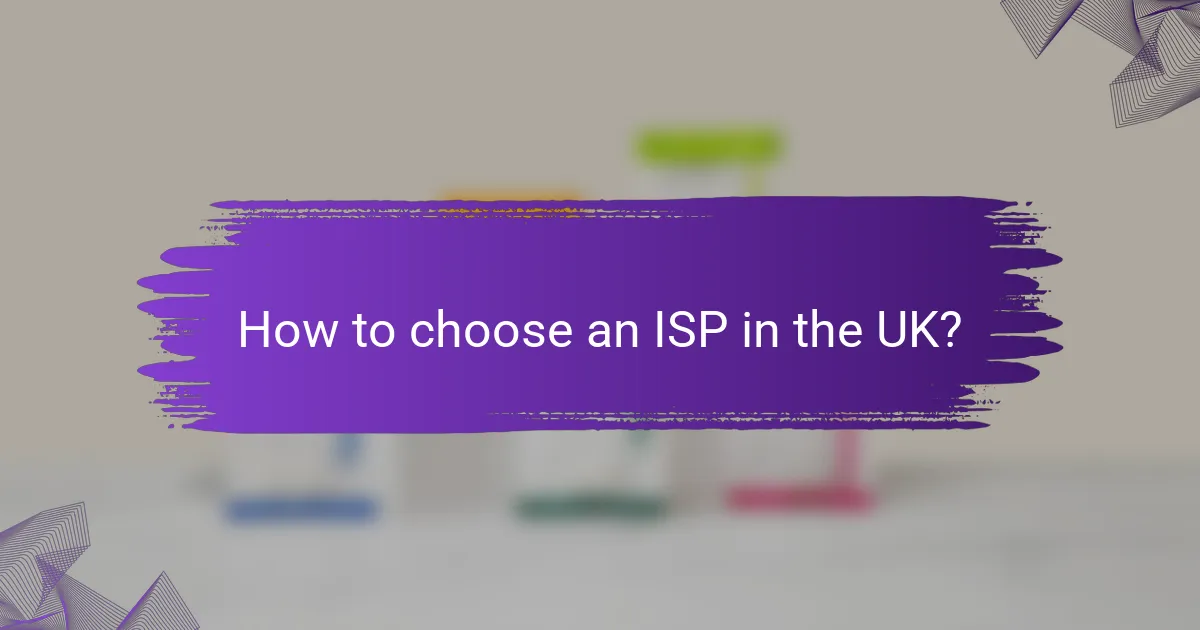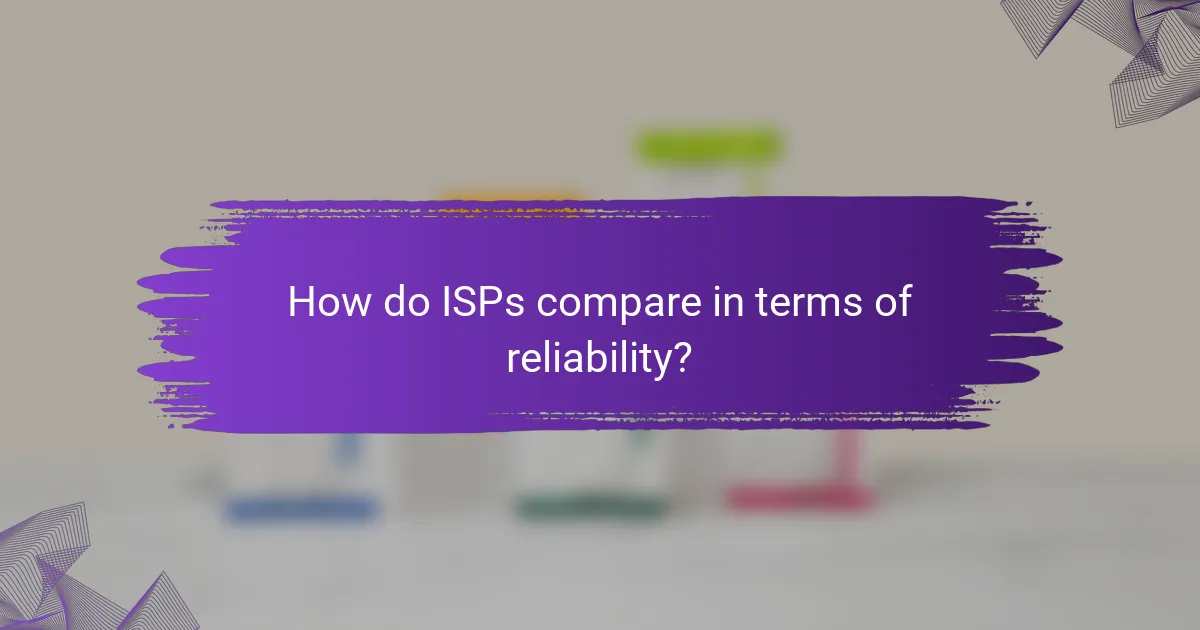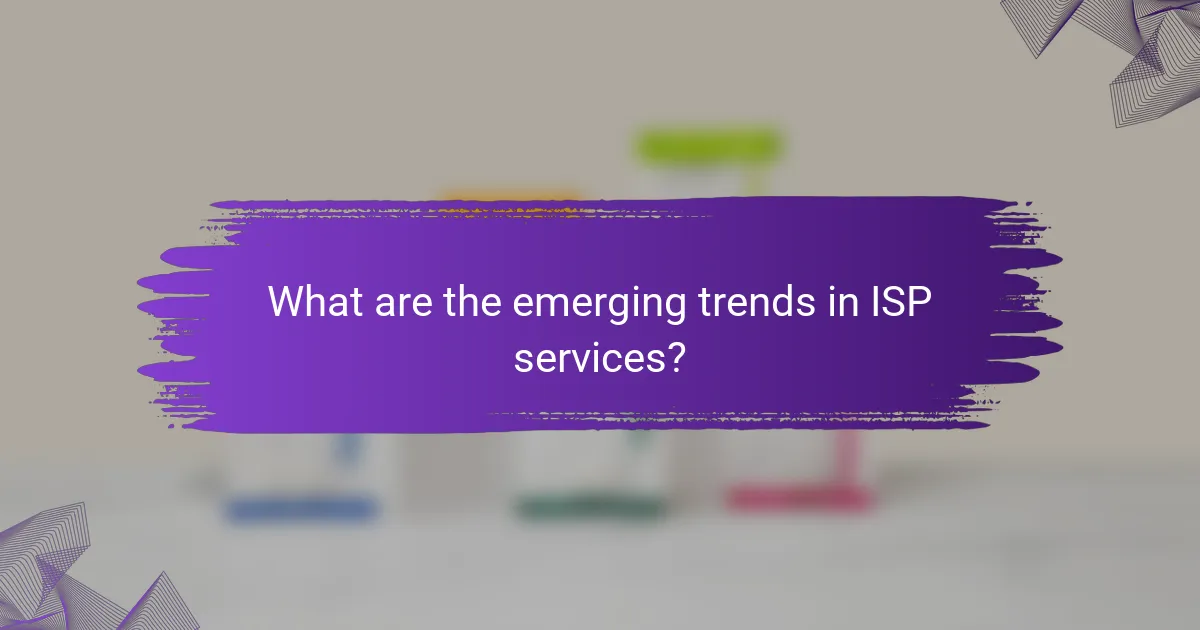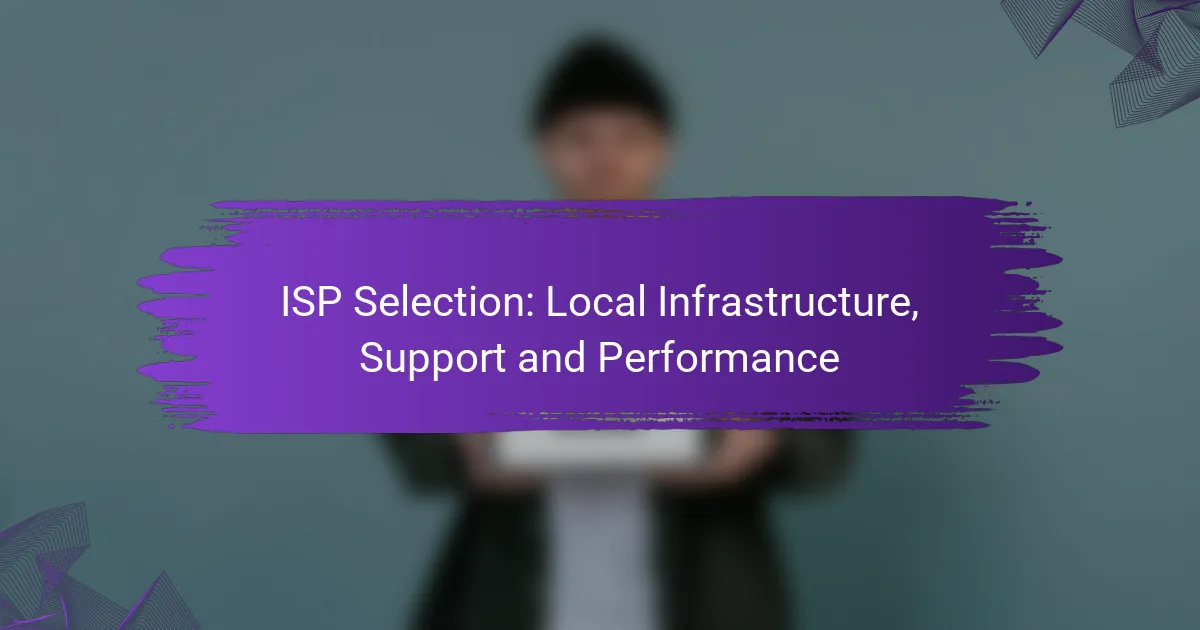Selecting the right Internet Service Provider (ISP) in the UK requires careful consideration of local infrastructure, customer support, and performance. The availability of different connection types, such as fibre optic and DSL, can greatly impact your internet experience, especially in varying geographical areas. Additionally, evaluating the quality and responsiveness of customer support is crucial for ensuring assistance during any technical difficulties.

How to choose an ISP in the UK?
Choosing an ISP in the UK involves assessing local infrastructure, customer support, and performance metrics. These factors will help you find a provider that meets your specific needs for speed, reliability, and service quality.
Consider local infrastructure availability
Local infrastructure is crucial when selecting an ISP, as it determines the type of services available in your area. Check whether providers offer fiber-optic, DSL, or cable connections, as fiber-optic generally provides the fastest speeds.
Use online tools to verify availability in your postcode area. Some ISPs may have limited coverage, so comparing options can help you find the best service for your location.
Evaluate customer support options
Customer support is a key aspect of your ISP experience. Look for providers that offer multiple support channels, such as phone, email, and live chat, to ensure you can get help when needed.
Read customer reviews to gauge the responsiveness and effectiveness of support teams. A provider with a strong reputation for customer service can save you time and frustration in the long run.
Assess performance metrics
Performance metrics like download and upload speeds, latency, and reliability are vital for a satisfactory internet experience. Aim for ISPs that offer speeds matching your usage needs, whether for streaming, gaming, or remote work.
Check independent speed tests and user reviews to verify the actual performance of ISPs in your area. Be cautious of advertised speeds, as they may not reflect real-world conditions.

What local infrastructure factors impact ISP selection?
Local infrastructure significantly influences ISP selection by determining the types of connections available, their reliability, and overall performance. Key factors include the presence of fibre optic networks, DSL, and cable options, which can vary widely between urban and rural areas.
Fibre optic coverage in urban areas
Fibre optic coverage is crucial in urban areas as it typically offers the fastest internet speeds and the most reliable connections. Many ISPs are expanding their fibre networks to meet increasing demand for high-speed internet, especially for activities like streaming and online gaming.
When selecting an ISP, check if they provide fibre optic service in your neighborhood. Areas with extensive fibre infrastructure can support speeds ranging from 100 Mbps to over 1 Gbps, making them ideal for heavy internet users.
Availability of DSL and cable options
DSL and cable internet options are often more widely available than fibre, especially in suburban and rural regions. DSL uses existing telephone lines, while cable internet relies on coaxial cables, both offering decent speeds but generally lower than fibre.
Consider the speeds offered by DSL and cable providers in your area, which typically range from 5 Mbps to 100 Mbps for DSL and 25 Mbps to 1 Gbps for cable. Evaluate your internet usage needs to determine if these options are sufficient, or if fibre is necessary for your requirements.

How does ISP customer support vary?
ISP customer support can differ significantly based on factors such as availability, response times, and the quality of assistance provided. Understanding these variations can help consumers choose an ISP that meets their needs for reliable support during technical issues.
24/7 support availability
Many ISPs offer 24/7 customer support, which is crucial for users who may experience issues outside of regular business hours. This constant availability ensures that customers can get help whenever they need it, whether it’s early in the morning or late at night.
However, not all ISPs provide round-the-clock support. Some may restrict their hours to standard business times, which can be a disadvantage for users who require immediate assistance. When selecting an ISP, check their support hours to ensure they align with your needs.
Response times for technical issues
Response times for technical issues can vary widely among ISPs. Some providers may resolve issues within minutes, while others could take several hours or even days to respond. Fast response times are essential for minimizing downtime and ensuring a smooth internet experience.
To gauge an ISP’s response times, look for customer reviews or ask current users about their experiences. Additionally, consider ISPs that offer multiple channels for support, such as phone, chat, and email, as this can enhance overall responsiveness.

What performance metrics should be considered?
When selecting an Internet Service Provider (ISP), key performance metrics include download and upload speeds, as well as latency and jitter rates. These metrics directly impact your online experience, affecting everything from streaming quality to gaming performance.
Download and upload speeds
Download and upload speeds are crucial for determining how quickly data is transferred to and from your devices. Download speed, measured in megabits per second (Mbps), indicates how fast you can receive data, while upload speed reflects how quickly you can send data. For most households, a download speed of at least 25 Mbps is recommended for smooth streaming and browsing.
Consider your household’s internet usage when evaluating these speeds. For example, if multiple users are streaming videos or gaming simultaneously, higher speeds—often in the range of 100-300 Mbps—may be necessary. Always check if the ISP offers plans that meet your specific needs.
Latency and jitter rates
Latency refers to the time it takes for data to travel from your device to its destination and back, typically measured in milliseconds (ms). Lower latency is essential for activities like online gaming or video conferencing, where real-time interaction is critical. A latency under 20 ms is generally considered excellent.
Jitter, on the other hand, measures the variability in latency. High jitter can lead to inconsistent performance, causing disruptions in streaming or gaming. Aim for a jitter rate below 30 ms for a stable connection. When assessing ISPs, inquire about their latency and jitter performance to ensure a reliable online experience.

What are the pricing models for ISPs in the UK?
ISPs in the UK typically offer various pricing models that include monthly subscription fees, contract lengths, and potential penalties for early termination. Understanding these models is crucial for selecting an ISP that fits your budget and usage needs.
Monthly subscription fees
Monthly subscription fees for ISPs in the UK generally range from around £20 to £60, depending on the speed and type of service. Basic packages often provide standard broadband, while higher fees may include fibre-optic connections with faster speeds. It’s essential to compare what each package offers to ensure you get the best value for your money.
Some ISPs may also offer promotional rates for the first few months, so be cautious of the long-term costs after the initial period ends. Always check if the fee includes installation costs or equipment rental, as these can add to your overall expenses.
Contract lengths and penalties
Most ISPs in the UK offer contracts that typically last between 12 to 24 months. Shorter contracts may be available but often come with higher monthly fees. It’s important to consider how long you plan to stay at your current address and whether you might need to move during the contract period.
If you decide to cancel your contract early, be aware that most ISPs impose penalties, which can range from a fixed fee to paying the remaining balance of your contract. Always read the terms carefully to understand the implications of early termination and look for ISPs that offer flexible options if you anticipate needing to change providers.

How do ISPs compare in terms of reliability?
ISPs vary significantly in reliability, primarily influenced by their infrastructure, service agreements, and customer support. Key factors to consider include uptime guarantees and customer satisfaction ratings, which provide insight into the consistency and quality of service.
Uptime guarantees
Uptime guarantees are commitments made by ISPs regarding the percentage of time their service will be operational. Most reputable ISPs offer uptime guarantees ranging from 99% to 99.9%, meaning they expect minimal downtime, often translating to only a few hours of service interruption per year.
When evaluating uptime guarantees, consider the implications of downtime on your needs. For businesses, even a few hours of downtime can result in significant losses, while residential users may prioritize cost over guaranteed uptime. Always check the fine print to understand what is covered and any penalties for not meeting these guarantees.
Customer satisfaction ratings
Customer satisfaction ratings reflect users’ experiences with an ISP’s service quality, support, and reliability. These ratings can be found on review platforms and industry surveys, often indicating how well an ISP meets customer expectations.
Look for ISPs with high satisfaction ratings, typically above 80%, as these providers are more likely to deliver reliable service. Additionally, consider reading reviews to identify common issues or strengths, such as responsiveness to outages or the quality of technical support. This information can help you make a more informed decision when selecting an ISP.

What are the emerging trends in ISP services?
Emerging trends in ISP services include the expansion of 5G internet options and a heightened focus on customer experience. These developments are reshaping how consumers access the internet and interact with their service providers.
Growth of 5G internet options
The rollout of 5G technology is significantly enhancing internet speeds and reducing latency for users. This next-generation mobile network offers download speeds that can exceed 1 Gbps, making it a compelling alternative to traditional broadband services.
As 5G becomes more widely available, ISPs are increasingly offering plans that leverage this technology. Consumers should consider the coverage area and device compatibility when evaluating 5G options, as availability can vary widely by location.
Increased focus on customer experience
ISPs are placing greater emphasis on customer experience, recognizing its importance in retaining subscribers. This trend includes improved customer support, transparent pricing, and user-friendly interfaces for managing accounts.
Many providers are now offering 24/7 customer service through multiple channels, such as chat, phone, and social media. Customers should look for ISPs that provide clear communication and responsive support to ensure a satisfactory experience.
